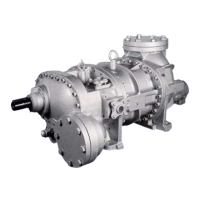REFRIGERATION DIVISION
V SERIES
SCREW COMPRESSOR HANDLING MANUAL
Supersedes all previous version. This information is for reference use only and subject to change without notice
Revision 2 (June 05,2000) Page 37 of 61
c) Inspect the unloader slide valve (54) and the frictional surfaces and clearance between the
variable Vi slide valve (289) and the casing (1).
Also, check if the Vi changing rod (444) and the unloader slide valve bushing (448) are fitted
together. If any wear or abnormal fitting is found, replace the parts.
d) Inspect the inner surface of the rotor casing.
If no rotor damage is found, there should be no damage or abnormality of the casing inner
surface either. If rotation traces are visible on the inner surface of the rotor casing, a problem
with the journals is the most probable cause. Performance will remain unchanged despite
wear of up to 0.3% of the rotor diameter; excessive wear of the leading edges of the rotors will
result in a drop in performance.
e) With some special applications, the bearing journal and the shaft seal portions are finished
with chrome plating. If any damage is found, contact the nearest MYCOM subsidiary for repair
or replacement.
3.4.11 Bearing Head (11) and Main Bearing (27)
Normally, further disassembly of this portion of the compressor is not required as there is nothing to
be gained from separation of the bearing head and rotor casing. Leave the two joined together.
To draw out the main bearing, remove the stop ring (29) from the bearing cover side using a pair of
pliers and push the main bearing out from the rotor casing side. If the bearing fit is tight, tap out using
a hammer cushioned with a plastic or wooden block. Do not strike the bearing directly with the
hammer.
Inspect the rotor shaft and the inner diameter of the bearing.
Also, examine the inner diameter of the bearing and the outer diameter of the rotor shaft to determine
if any foreign matter is imbedded in the bearing metal.
Inspect the O-ring (451) of the Vi changing rod (444) for damage or other abnormality.
4. Reassembly
When disassembly, inspection and any necessary repair work are completed, the compressor must
be correctly reassembled. Before commencing reassembly, confirm that all parts are available.
Reassembly work is essentially carried out in the reverse order of disassembly. All tools and parts
should be cleaned thoroughly before beginning reassembly and parts should be coated with
compressor oil before being mounted.
4.1 Bearing (11) Head and Main Bearing (27)
a) The main bearing is clearance fitted in some cases while it is lightly press fitted in others.
Arrange a simple jig (washer and bolt) to fit the main bearing.
A positioning spring pin (14) is provided on the bearing head. Align the pin with the notch in
the main bearing (11). If the bearing must be tapped in, cushion with a plastic or wooden
block.
If the bearing gets out of position as it is being inserted, remove and carefully insert again.
Be sure to fit the O-ring oil retainer (432) provided on the outer diameter.
b) Mount the stop ring (29) to secure the bearing.
c) Confirm that the O-ring (451) is properly fitted in the hole for the V
i
changing rod.

